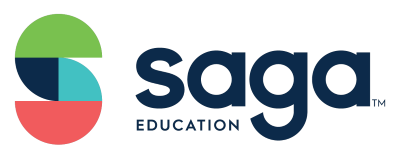5 important criteria of effective tutoring programs — Saga Education
October 2, 2019Although Saga’s core program model is in-school, many people are curious and occasionally ask us about private tutoring options for students outside of school and what important elements to look out for when seeking individuals, companies, or programs to work with. Here are 5 important criteria that we believe represent the most effective tutoring programs.

1. Relationships First: Strong tutors, or tutoring organizations, recognize that relationships with students and families are essential for student achievement. Students who know that a tutor is genuinely invested in his or her success will be more motivated to work harder. Effective tutors take time to know their students and their interests, their strengths, their weaknesses and their fears. This is no different for parents. The organization should establish meaningful and regular communication with the families to celebrate success and to review their children’s work and progress. Tutors should empower parents to support their child’s success by introducing them to useful resources or by giving meaningful recommendations.
2. The right mindset: Often times students’ struggles involve not the content itself, but rather their confidence and effort. The best tutors help students learn the value of productive struggle in academics, so they are not fearful of failure and mistakes but instead celebrate challenges as opportunities for growth.
3. Adequate feedback and training: Whether tutors are highly experienced teachers or volunteers, ongoing training is critical for success. Parents should not only ask about the initial qualifications of the tutors, but also about their avenues for collecting feedback and for seeking continual training opportunities. When working with a private tutor, does he or she actively welcome and seek feedback from the parent and student?
4. Assessments to guide instruction: An assessment is used to evaluate where students are in their learning progress, but they do not always have to be tests. An assessment could simply involve watching a student complete their math work. Regardless of how it is done, the organization or individual tutor should have tools to understand a child’s knowledge/skill gaps as well as their progress over time. This information should guide the tutor’s approach and instructional plan. These tools should be used often to ensure retention of information, skills and key ideas. Having quantitative and qualitative information has two other benefits. They will help you understand the value-add of having the tutor and will give you a benchmark with which you can hold the tutor or company accountable.
5. Conceptual Mastery Over Memorization: It’s key that tutors work to weed out misconceptions and lay a solid and appropriate conceptual foundation. This is especially true when it comes to math. Historically, we have taken an algorithmic approach to math, which involves memorizing steps, for which students see no recognizable end. Good tutoring allows students to see math as a creative endeavor with multiple paths available to arrive upon the solution to a problem. Algorithms are tools we can use to make math more efficient, but they should not precede or supplant the conceptual development of ideas in math.
